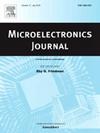A 10–15 GHz four-antenna phased array beamforming receiver with eight-simultaneous beams in 55-nm CMOS Technology
IF 1.9
3区 工程技术
Q3 ENGINEERING, ELECTRICAL & ELECTRONIC
引用次数: 0
Abstract
This paper demonstrates a 10–15 GHz four-antenna phased array beamforming receiver with eight-simultaneous beams. The full-connected multibeam architecture is adopted to maximize the beamforming gain. To mitigate the design complexity and large chip area-consumption caused by the multibeam combination, a compact active multibeam combining technique is proposed, which features current-domain phase shifted signal combining and compact passive signal connection network. Implemented in a 55-nm CMOS process, the receiver consumes a current of 1100 mA with a 1.2 V supply. From 10 to 15 GHz, the receiver achieves a 360° phase shifting range with a 6-bit resolution, and the root mean square (RMS) phase is less than 3°. The 6-bit attenuator in each output channel achieves less than 0.4 dB root mean square (RMS) gain error. The receiver demonstrates a gain of 20 dB (20.5 dB), a 5.5 dB (7.6 dB) noise figure, and an input-referred 1 -dB gain compression point (IP1dB) of −20 dBm (−22 dBm) at 10 GHz (15 GHz), respectively. The chip size, including pads, is only 3.6 × 5.4 mm2.
基于55纳米CMOS技术的10-15 GHz四天线相控阵波束形成接收机
本文演示了一种10 - 15ghz四天线相控阵波束形成接收机,具有8个同时波束。采用全连接多波束结构,使波束形成增益最大化。针对多波束组合系统所带来的设计复杂性和芯片面积消耗大的问题,提出了一种紧凑的有源多波束组合技术,该技术具有电流域相移信号合并和紧凑的无源信号连接网络的特点。在55纳米CMOS工艺中实现,接收器在1.2 V电源下消耗1100ma电流。在10 ~ 15 GHz范围内,接收机实现360°相移范围,分辨率为6位,均方根相位小于3°。每个输出通道的6位衰减器实现小于0.4 dB的均方根增益误差。该接收机在10 GHz (15 GHz)下的增益为20 dB (20.5 dB),噪声系数为5.5 dB (7.6 dB),输入参考1dB增益压缩点(IP1dB)分别为- 20 dBm (- 22 dBm)。包括衬垫在内的芯片尺寸仅为3.6 × 5.4 mm2。
本文章由计算机程序翻译,如有差异,请以英文原文为准。
求助全文
约1分钟内获得全文
求助全文
来源期刊

Microelectronics Journal
工程技术-工程:电子与电气
CiteScore
4.00
自引率
27.30%
发文量
222
审稿时长
43 days
期刊介绍:
Published since 1969, the Microelectronics Journal is an international forum for the dissemination of research and applications of microelectronic systems, circuits, and emerging technologies. Papers published in the Microelectronics Journal have undergone peer review to ensure originality, relevance, and timeliness. The journal thus provides a worldwide, regular, and comprehensive update on microelectronic circuits and systems.
The Microelectronics Journal invites papers describing significant research and applications in all of the areas listed below. Comprehensive review/survey papers covering recent developments will also be considered. The Microelectronics Journal covers circuits and systems. This topic includes but is not limited to: Analog, digital, mixed, and RF circuits and related design methodologies; Logic, architectural, and system level synthesis; Testing, design for testability, built-in self-test; Area, power, and thermal analysis and design; Mixed-domain simulation and design; Embedded systems; Non-von Neumann computing and related technologies and circuits; Design and test of high complexity systems integration; SoC, NoC, SIP, and NIP design and test; 3-D integration design and analysis; Emerging device technologies and circuits, such as FinFETs, SETs, spintronics, SFQ, MTJ, etc.
Application aspects such as signal and image processing including circuits for cryptography, sensors, and actuators including sensor networks, reliability and quality issues, and economic models are also welcome.
 求助内容:
求助内容: 应助结果提醒方式:
应助结果提醒方式:


